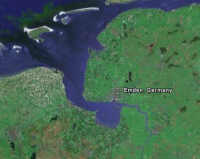
 |
||
| Home - People - Participants - Research - Publications - Contact Us |

|
Dynamics of Estuarine Turbidity Maxima (ETM):coupling of morphology and biology
LOICZ project 014.27.013 Dr. Stefan Talke - Prof. Dr. Victor de Jonge - Prof. Dr. Huib de Swart Over the past ~20 years, major changes have occurred on the Ems estuary. The river has been deepened from ~ 4m to depths of greater than 6m, increasing tidal amplitudes by ~ 1m and pushing the system more towards a standing wave (resonance conditions). As a result of these changing dynamics and continued dredging, the sediment concentrations in the estuary turbidy maximum (ETM) have increased by over an order of magnitude, from an average of 200 mg/L from 1970-1979 to several g/L. Sediment concentrations greater than 10 g/L have been measured in surface water at the ETM! The system has also shifted from sandy to muddy, and a fluid mud layer of up to 2-3m thickness now occurs near the ETM. The high sediment concentrations and fluid mud layer near the ETM have caused both economic and environmental problems on the Ems. The continual (re)deposition of sediment requires continual and costly dredging: annual dredging costs approach ~24 million euros a year between Emden and Papenburg, and approach an additional 7 million euros from Emden to the North Sea. Moreover, the fluid mud layer and its high biological oxygen demand lead to oxygen depletion and anoxic conditions during the summer months. As a result, the ecology of the Ems estuary is extremely stressed. Planned deepening of the river to accomodate shipping demands may increase both the economic and environmental costs. The goal of the project is to investigate the coupling between biological and hydrodynamic processes at the Estuary turbidity maximum of the Ems river, from both an experimental and numerical modeling standpoint. We are interested in changes to the physics and biology over many time scales, from tidal to seasonal to multiple years. To understand the Ems environment better, we are therefore asking these broad questions: what are the most important physical processes that are leading to the high sediment concentrations at the ETM? How do man-made (such as dredging and the Ems speerwerk) and natural (such as sea level rise) perturbations to the environment affect the hydrodynamics, sediment transport, and ecology? In what ways are the physical and biological characteristics of the Ems linked? To answer these questions, we are investigating both the physics of the estuary--tides, residual currents, sediment (scalar) transport, mixing processes--as well its water quality--algal distribution, algal speciation, and nutrient availability such as oxygen, nitrates, phospates, and silicates. Between February 2005 and May 2006 we are measuring the hydrodynamic and bio-chemical properties of the estuary along both longitudinal and cross-sectional transects. The physical measurements include ADCP, CTD, OBS, fluorometer, oxygen, and echosounder data. Water samples are taken at selected stations and analyzed for suspended sediment concentration, total organics (carbon), nitrates, phospates, silicates, and algae concentration. Agencies assisting us with measurements include the Wasser und Schifffahrtsamt Emden, Niedersachsen Ports GmBH.Emden, Rijkswaterstaat, Bundes Anstalt für Wasserbau Hamburg, NLWKN Aurich, Bundesanstalt für Gewässerkunde Koblenz and Alfred Wegener Institut Bremerhaven. These physical measurements will be used to isolate important processes in the physics and biology of the environment, and give insight into their coupling. In addition, the physical measurements will serve to help calibrate and validate numerical models that are being developed to characterize the system. Our numerical modeling philosophy is to simplifiy the physical system as much (but not more) than possible, and therefore understand fundamental processes (rather than builiding a large model with predictive capability but little physical intuition).
The ETM group is part of the coastal group of the physical oceanography section fo the Institute for Marine and Atmospheric Studies, Utrecht (IMAU). The IMAU is part of the Department of Physics and Astronomy at the University of Utrecht, Netherlands.
This project is financed by the Netherlands Organization for Scientific Research (NWO, see http://www.nwo.nl/), section Earth & Life Sciences (ALW), as part of the program 'Land-Ocean Interaction in the Coastal Zone' (LOICZ).
last modified: 10-03-2006 16:01 |
|
||||||